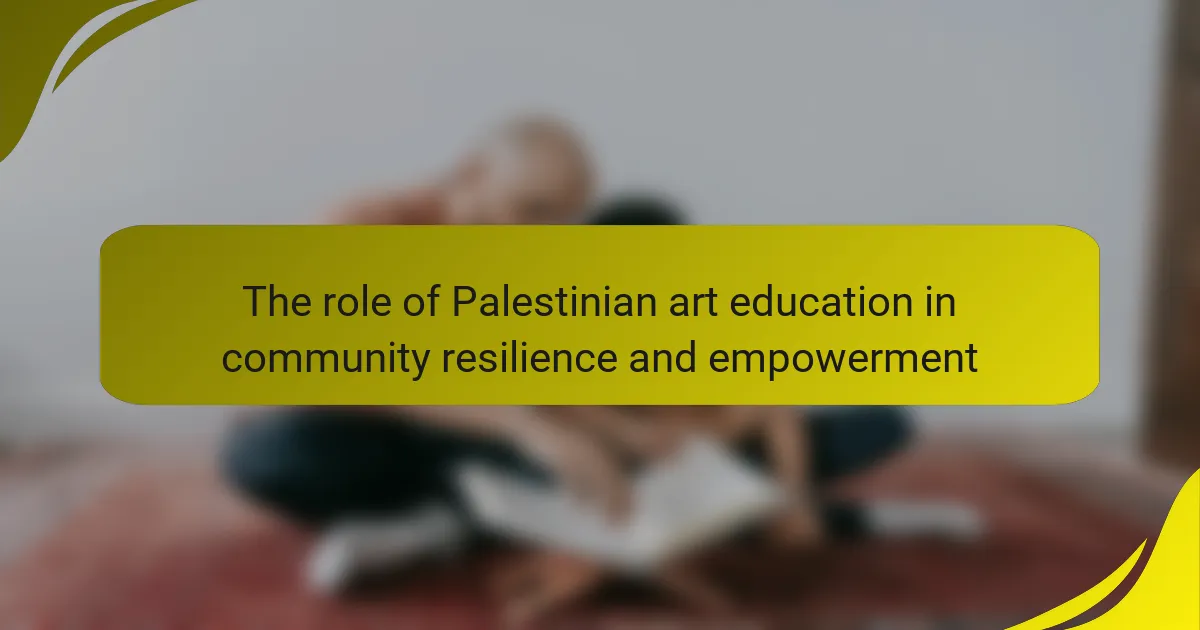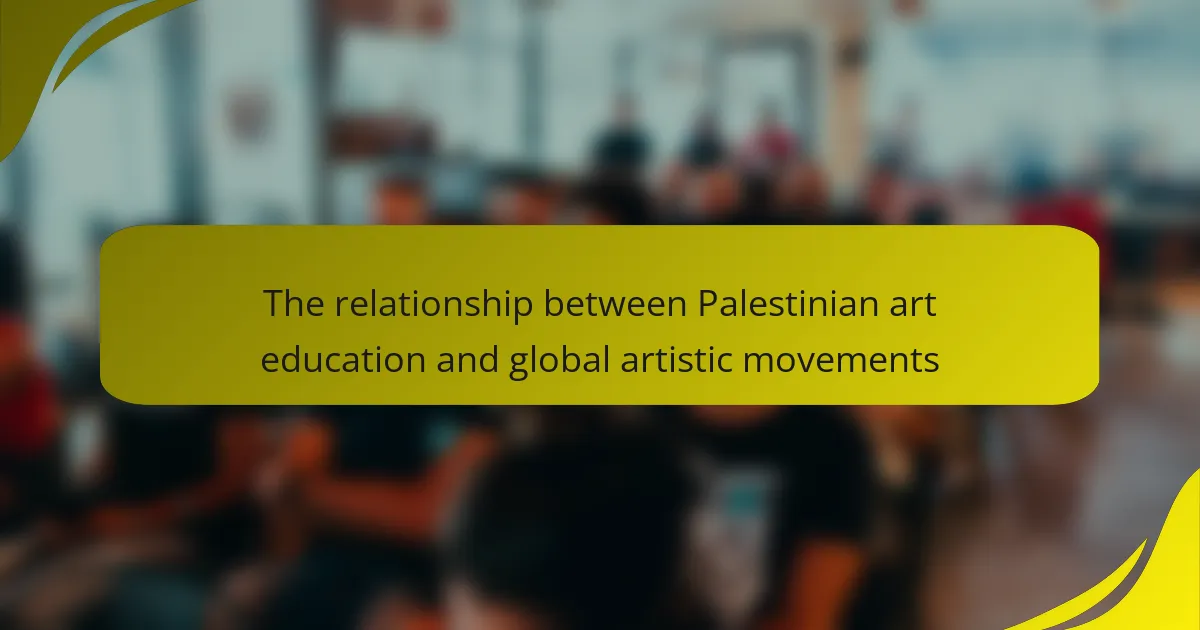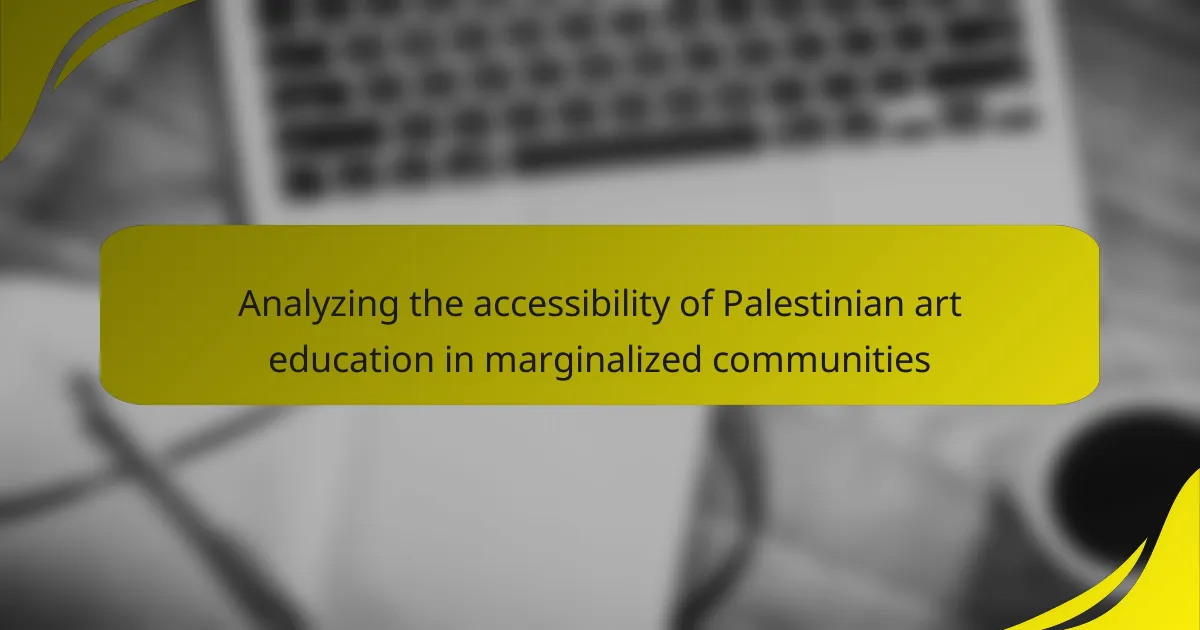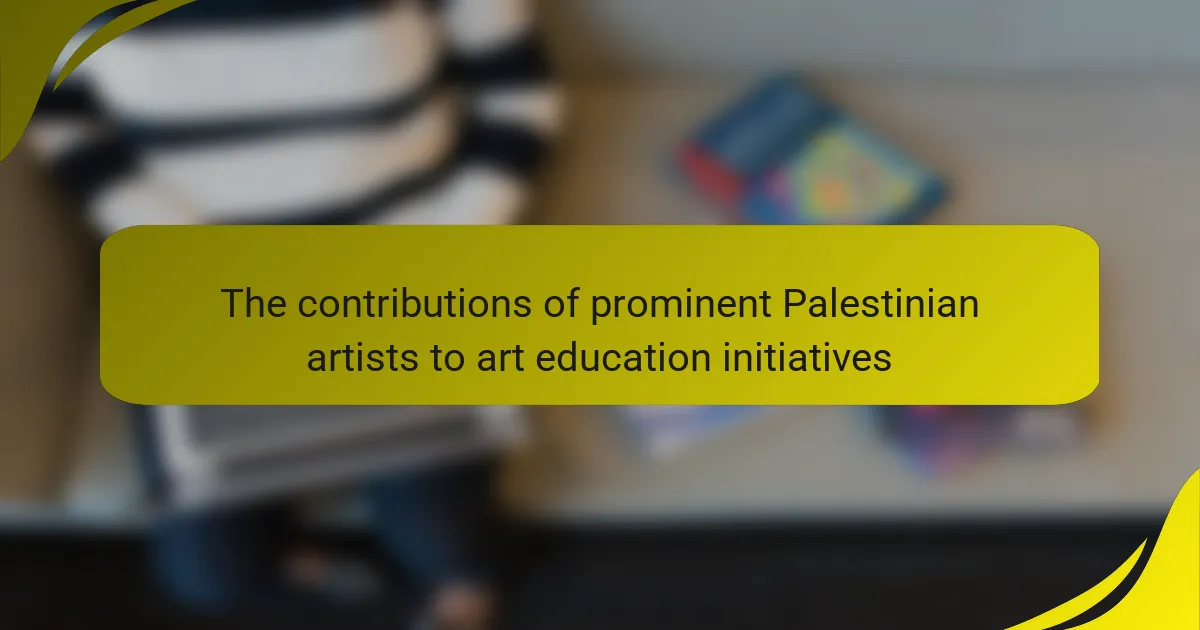Technology significantly enhances Palestinian art education experiences by providing access to diverse artistic resources and platforms. Digital tools allow students to explore various art forms and techniques, while online workshops and tutorials facilitate skill development. Virtual collaborations connect artists globally, and technology aids in documenting and sharing Palestinian art. Social media platforms increase visibility for student work, fostering appreciation for Palestinian culture. Overall, technology enriches the educational landscape for aspiring Palestinian artists.
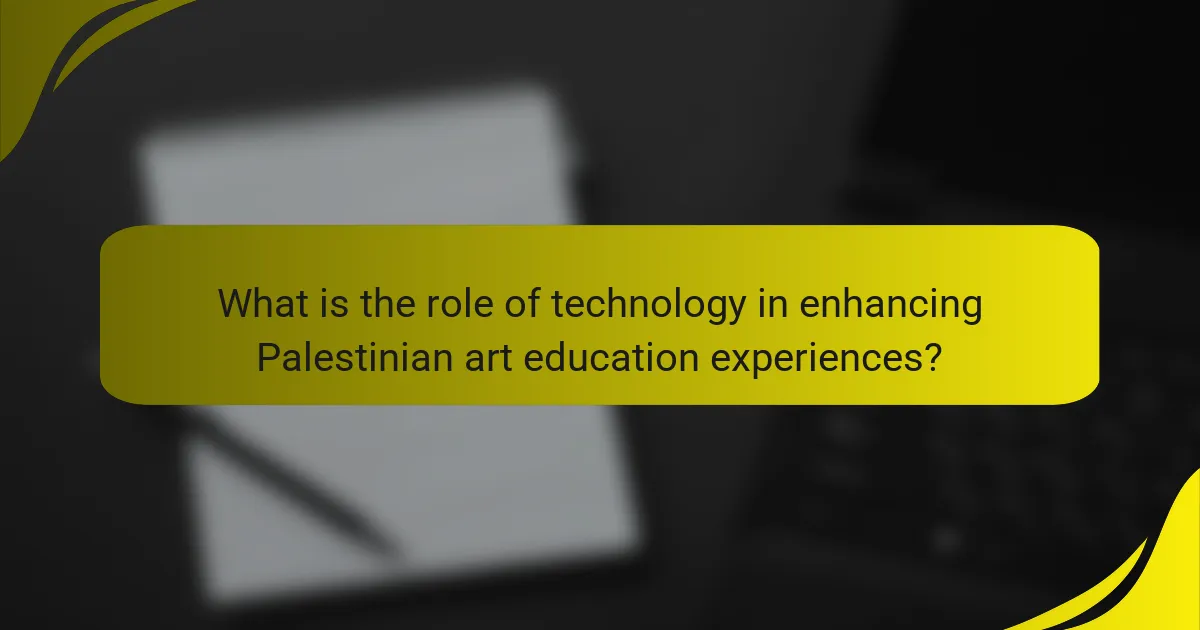
What is the role of technology in enhancing Palestinian art education experiences?
Technology plays a significant role in enhancing Palestinian art education experiences. It provides access to diverse artistic resources and platforms. Digital tools enable students to explore various art forms and techniques. Online workshops and tutorials facilitate skill development. Virtual collaborations allow artists to connect globally. Technology also helps in documenting and sharing Palestinian art. Social media platforms showcase student work to a wider audience. This increased visibility can foster appreciation for Palestinian culture. Overall, technology enriches the educational landscape for aspiring Palestinian artists.
How has technology been integrated into Palestinian art education?
Technology has been integrated into Palestinian art education through various digital platforms and tools. Art educators utilize online resources to enhance learning experiences. Virtual workshops and webinars allow for broader participation. Digital art software is increasingly used in curriculum development. Students access global art movements and styles through the internet. Social media platforms facilitate sharing and collaboration among artists. Additionally, technology aids in documenting and archiving Palestinian art. This integration fosters creativity and innovation in artistic expression.
What specific technologies are being utilized in this context?
Virtual reality (VR) and augmented reality (AR) are specific technologies utilized in enhancing Palestinian art education experiences. These technologies provide immersive learning environments. Students can explore art history and techniques interactively. Digital platforms facilitate online art classes and workshops. Mobile applications offer access to art resources and tutorials. Collaborative tools enable students to share and critique artwork remotely. Social media platforms serve as spaces for showcasing student art. These technologies collectively enhance engagement and accessibility in art education.
How do these technologies impact teaching methods in art education?
Technologies significantly enhance teaching methods in art education by providing innovative tools and resources. They facilitate interactive learning experiences through digital platforms and applications. For instance, virtual reality (VR) allows students to immerse themselves in art history and techniques. This engagement improves understanding and retention of artistic concepts. Additionally, online collaboration tools enable students to work together, regardless of location. These tools foster creativity and peer feedback. Research shows that integrating technology in art education leads to increased student motivation and participation. According to a study by the International Society for Technology in Education, students using technology in art classes reported higher satisfaction and improved skills.
What are the benefits of using technology in Palestinian art education?
Using technology in Palestinian art education enhances creativity and accessibility. It provides students with diverse digital tools for artistic expression. Students can access online resources, tutorials, and platforms for sharing artwork. This fosters collaboration among artists and educators. Technology also allows for the integration of global art trends into local curricula. Virtual classes can reach students in remote areas. Additionally, technology can document and preserve Palestinian art heritage. This ensures that cultural narratives are maintained and shared. Overall, technology enriches the learning experience in Palestinian art education.
How does technology enhance student engagement in art classes?
Technology enhances student engagement in art classes by providing interactive tools and resources. Digital platforms allow students to explore various art forms and techniques. Tools like graphic design software enable creativity and experimentation. Virtual reality can immerse students in art history and techniques. Online galleries and social media facilitate sharing and feedback on student work. These technologies foster collaboration among students and artists worldwide. Research shows that technology integration increases motivation and participation in creative tasks. A study by the National Art Education Association found that 73% of educators reported improved student engagement through technology use in art education.
What role does technology play in expanding access to art education?
Technology plays a significant role in expanding access to art education by providing diverse learning platforms. Online courses and virtual classrooms enable students from various backgrounds to participate in art education. This accessibility is crucial in regions with limited physical resources. Digital tools also facilitate collaboration among artists and educators across geographical boundaries. For instance, platforms like Zoom and Google Classroom allow real-time interaction and feedback. Furthermore, social media and online galleries provide exposure to a wider audience, enhancing visibility for emerging artists. Statistics show that online enrollment in art courses has increased by over 200% in recent years. This shift demonstrates how technology democratizes art education, making it more inclusive and far-reaching.
What challenges are faced in implementing technology in Palestinian art education?
Palestinian art education faces several challenges in implementing technology. Limited access to reliable internet hampers online learning and resource sharing. Additionally, inadequate funding restricts the acquisition of modern technological tools. A lack of training for educators on technology use further complicates implementation. Cultural and political factors also create barriers to integrating technology into curricula. These challenges hinder the development of innovative teaching methods and access to global art trends.
What are the barriers to access for students and educators?
Barriers to access for students and educators in Palestinian art education include limited technology infrastructure, lack of training, and economic constraints. Many schools lack reliable internet access and modern devices. This hinders the integration of technology in art education. Educators often do not receive adequate training to utilize available tools effectively. Additionally, financial limitations restrict access to necessary resources and materials. According to a UNESCO report, 70% of schools in Palestine face challenges related to technology integration. These barriers significantly impact the quality of art education experiences for both students and educators.
How do socio-political factors influence technology use in education?
Socio-political factors significantly influence technology use in education. These factors include government policies, funding availability, and cultural attitudes towards technology. For instance, in regions with unstable political climates, educational institutions may lack access to modern technology. This limits the integration of digital tools in teaching practices. Additionally, governmental support can drive technology adoption through funding initiatives. Research shows that countries prioritizing educational technology see improved student engagement. In contrast, socio-political tensions can hinder collaboration and resource sharing among educational institutions. Ultimately, the socio-political landscape shapes the extent and effectiveness of technology use in educational settings.
How can technology be effectively utilized to improve art education experiences?
Technology can be effectively utilized to improve art education experiences by incorporating digital tools and platforms. These tools facilitate interactive learning and enhance creativity. Virtual reality (VR) can immerse students in art history and different cultures. Online collaboration platforms enable students to work together on projects regardless of location. Digital art software allows for experimentation with various techniques and styles. Access to online resources broadens exposure to diverse artistic practices. Mobile applications provide tutorials and feedback, enhancing skill development. Research indicates that integrating technology in education increases engagement and motivation among students. Studies show that students using technology in art education demonstrate improved artistic skills and critical thinking.
What best practices should educators follow when integrating technology?
Educators should follow several best practices when integrating technology. First, they must align technology use with learning objectives. This ensures that technology enhances educational goals rather than distracts from them. Second, educators should provide training for both teachers and students. Effective training maximizes the benefits of technology and fosters confidence in its use. Third, they should select appropriate tools that cater to diverse learning styles. This inclusivity enhances engagement and comprehension among students. Fourth, regular assessment of technology’s impact on learning is essential. This allows for adjustments to improve effectiveness. Finally, educators should foster a collaborative environment. Collaboration encourages peer learning and enhances creativity. Research shows that effective technology integration can lead to improved student outcomes (Hattie, 2012).
How can collaboration with tech companies enhance art education initiatives?
Collaboration with tech companies can significantly enhance art education initiatives. This partnership provides access to advanced tools and resources. For example, software for digital art creation can improve students’ skills. Additionally, tech companies can offer training for educators on integrating technology into lessons. This leads to more engaging and interactive learning experiences. Research indicates that technology in education boosts student motivation and creativity. A study by the Education Development Center found that students using digital tools showed a 25% increase in engagement. Therefore, collaboration with tech companies can create a more dynamic art education environment.
What future trends can we expect in the intersection of technology and Palestinian art education?
Future trends in the intersection of technology and Palestinian art education include increased use of digital platforms for learning. Online courses and virtual workshops will become more prevalent. These platforms can provide access to global art educators and resources. Additionally, augmented reality (AR) and virtual reality (VR) will enhance immersive learning experiences. Students can explore art history and techniques in interactive environments. Social media will also play a crucial role in showcasing Palestinian artists and their work. This will foster a broader audience and community engagement. Finally, collaboration with tech companies may lead to innovative tools tailored for art education. These trends indicate a significant shift towards integrating technology in Palestinian art education.
How might emerging technologies shape the future of art education?
Emerging technologies will significantly shape the future of art education by enhancing accessibility and engagement. Virtual reality (VR) and augmented reality (AR) can create immersive learning experiences. These technologies allow students to explore art history and techniques in a hands-on manner. Online platforms facilitate global collaboration among artists and educators. This connectivity broadens perspectives and enriches the learning process. Additionally, artificial intelligence can provide personalized feedback on student work. Research indicates that technology integration in education improves student outcomes and engagement. For example, a study by the International Society for Technology in Education highlights increased creativity in students using digital tools. Overall, emerging technologies will transform how art education is delivered and experienced.
What innovations are on the horizon for enhancing art education experiences?
Innovations on the horizon for enhancing art education experiences include virtual reality (VR) and augmented reality (AR) tools. These technologies allow immersive experiences that can engage students in new ways. For instance, VR can transport students to art museums worldwide, broadening their exposure to diverse artworks. AR can overlay digital information on physical artworks, providing context and interactive learning opportunities. Additionally, online collaborative platforms are emerging, enabling students to work together regardless of location. These platforms foster creativity and peer feedback. Furthermore, artificial intelligence (AI) is being integrated into art education, offering personalized learning experiences. AI can assess student progress and suggest tailored resources. Finally, 3D printing technology is making it easier for students to create tangible art forms from their digital designs. These innovations collectively aim to make art education more accessible and engaging.
What practical tips can educators use to leverage technology in art education?
Educators can leverage technology in art education by integrating digital tools and platforms into their curriculum. They can use software like Adobe Creative Suite for graphic design projects. Online platforms such as Google Classroom facilitate collaboration and feedback. Virtual reality tools can offer immersive art experiences. Educators should encourage students to create digital portfolios to showcase their work. Utilizing social media can promote student art and connect them with broader audiences. Online resources and tutorials can enhance skill development. Incorporating 3D printing can expand creative possibilities in art projects. Finally, educators should provide training sessions on new technologies to ensure effective usage.
The main entity of this article is technology’s role in enhancing Palestinian art education experiences. The article explores how technology provides access to diverse artistic resources, facilitates skill development through digital tools, and enables global collaboration among artists. It discusses specific technologies like virtual reality (VR) and augmented reality (AR), their impact on teaching methods, and the benefits of increased student engagement and accessibility in art education. Additionally, it addresses the challenges faced in implementing technology, including socio-political factors and barriers to access, while highlighting future trends and innovations that may shape art education experiences in Palestine.
